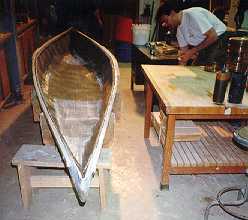

IntroductionUnion College was chartered in 1795, the first College chartered by the Regents of the State of New York. Union is one of twelve colleges and universities in the country founded before 1800. In 1845, Union became the first liberal arts college to offer engineering. The college is located in Schenectady, New York, about 15 miles west of Albany and has about 2000 full time undergraduates. Our primary goals for this year's competition are to produce a boat with a more uniform hull thickness, refine the finish of the hull and reduce the overall weight. A forensic investigation of last year's boat indicated that these were the areas where improvement was needed. |
 |
Hull DesignThe hull design presented in this year's competition is a refinement of last year's design. It is designed for ease in maneuverability and stability and can be classified as a shallow arch design. The female mold that was made for last years construction was used to form this years canoe as well. The male mold used in previous years was made of styrofoam sections that had been shaped to a rough approximation of the final hull design. The styrofoam was coated with an epoxy body filler and sanded to obtain a smooth finish. From the male mold a fiberglass female mold was constructed and used to form this years canoe. The refined hull has dimensions of 17 ft. - 1 in. long by 34 in. wide (at its widest point). The widest point is 16.59% of the length, well within the design and construction requirements. The average depth at the bow is 12 in. and average depth through out the rest of the section is 10 in. spacers and the 20 gauge tie wire. To provide extra lateral support, ceiling grid wire was secured to the wire mesh laterally every two feet. This was done by using 20 gauge tie wire. Reinforcement for the thwart was made of the secondary reinforcement material. The thwart was formed using a wooden jig that was placed at the widest point of the canoe. The ceiling grid was used to reinforce the thwart. First the wire was wrapped around the inside of the canoe laterally. It should be noted that the ceiling grid wire was placed on top of the wire mesh and secured using the 20 gauge tie wire. A turnbuckle was used to create tension in these wires. The turnbuckle was placed in the middle of the thwart and was spaced off the bottom of the thwart mold. Separate pieces of ceiling grid wire were strung through the thwart form and the ends were spread out diagonally at a length of about 4 feet. The secondary reinforcement was tied into place with 20 gauge tie wire during the casting process. |
 |
Project Management/Cost AssessmentOrganizational approach |
 |
| Management techniques By dividing the management responsibilities between two people, communication between the two managers was essential. To facilitate communication and to make sure that the overall project was proceeding in a timely fashion, meetings with the two managers and the faculty advisor for the Union College ASCE Student Chapter were held at least once a week. These meetings were used to discuss and resolve any problems that arose as work proceeded. The only major management problem that arose was getting members of the design and construction team and competition team to show up to work on the canoe. We quickly discovered that a good technique for getting people to work on the canoe was to provide food. Innovative FeaturesOur principal innovative feature for this year's canoe was the use of a female mold and the spacers to properly place the reinforcement. Forming the spacers from a test cylinder of our concrete mix design allowed us to incorporate the spacers as a part of the canoe. This approach significantly reduced the amount of patching required at the points where the primary reinforcement was attached to the female mold. Additionally, wire were tied through the thwart, around the hull, and tensioned with a turnbuckle. Lastly, the gunwale was dropped using plywood molding to reduce the overall weight of the canoe. |
 |
Please direct all comments, suggestions, and queries about this page to CE-Webmaster